APTA Rail 2010: Rail project updates from various agencies
APTA Rail 2010: Rail project updates from various agencies
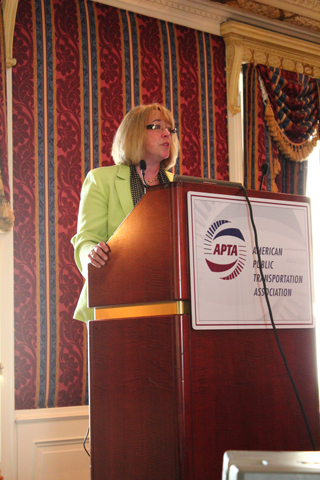
(If you haven’t heard by now, TransLink is hosting the 2010 APTA rail conference this week! See the APTA Rail 2010 category for more posts.)
Tuesday morning was the Project Update section of the conference, where 20 agencies presented updates on their latest rail projects in 10 back-to-back 30-minute sessions. A great way to catch up on what other agencies are up to!
I couldn’t see everything, since for each session, two agencies presented updates simultaneously in two separate rooms —but I did manage catch most of the updates from Sonoma County in California, Edmonton Transit, Calgary Transit, AMT in Montreal, TriMet in Portland and Toronto’s TTC.
What follows are my summaries of each presentation. Some overarching thoughts:
a) Once again, rail projects are expensive: the cheapest project I saw was a three-mile $425 million Edmonton Ellerslie LRT extension, and everything else seemed to cost billions.
b) Big events can prompt rail investment: GO Transit’s Air Rail Link is moving due to the Pan-Am Games in 2015; a bid for the World’s Fair in 2017 is helping spur Edmonton’s LRT growth
c) Funding and oversight for rail projects is quite different in the U.S.: the federal government is the key funder and overseer, and it’s currently very keen on public transit – also lots of agencies get funding from local sales tax, which has dropped sharply in the economic recession
By the way, corrections are welcome: I’ve only transcribed what I heard so there may well be a few errors here and there!
SMART commuter rail in Northern California: Sonoma Marin Area Rail Transit District, San Rafael, CA
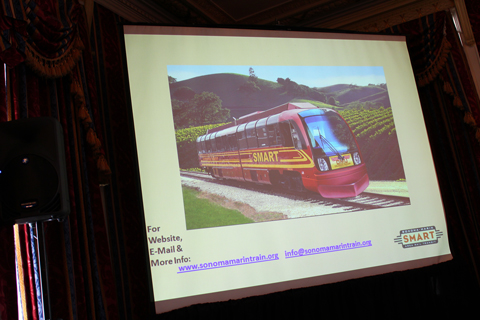
Lillian Hames, general manager, Sonoma Marin Area Rail Transit District
First, I’d just like to point out that the acronym for Sonoma Marin Area Rail Transit District is SMART. Very clever, guys :)
Lillian’s update talked about the new 70-mile commuter line that SMART is building on an old historic rail line in Marin and Sonoma County. It was a 30-year process to acquire the line from the private owners. (As I’ve said before, it’s pretty amazing how track lines laid a hundred years ago still shape transportation patterns everywhere, isn’t it?)
The rail line is a single track system, running north-south from the border of Mendocino to Larkspur, where a ferry to San Franscisco docks. It’s planned for shared use with freight service, and the freight operator will be selected by SMART. They’re projecting 7000 daily riders, and they hope to be operating by 2013.
As all California rail projects have to, the SMART project had to go to the ballot for funding, requiring 2/3 of the region to vote yes on their proposal and provide the project with sales tax revenue. The tax generates $1.1 billion over 20 years, with half going to capital cost and the rest to maintenance and operations in that time. They are eventually going to go back to the voters to ask to extend that funding.
A key component of this project is a parallel bike and pedestrian pathway: there’s a big system of bike pathways in the region, and SMART is very eager to integrate them into the rail project. The draft designs for the train interiors even had one car that was basically 75% bike racks!
You can find out more about the project at sonomamarintrain.org.
Edmonton’s LRT Projects – Building a Sustainable City
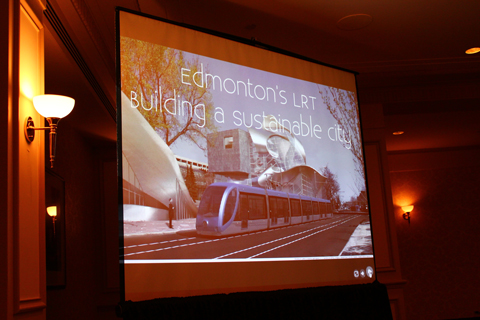
Brad Smid, P.Eng.,project manager, LRT design & construction, City of Edmonton, Edmonton, AB
Carole Cej, P.Eng., senior engineer, LRT expansion, City of Edmonton, Edmonton, AB
Chris Link, P.Eng., integration manager -Team North LRT, Stantec Consulting Limited, Edmonton, AB
Brad, Carole, and Chris gave an overview of the LRT expansion currently underway in Edmonton.
Some basic city facts: Metro the City of Edmonton has a population of over 1 million, spread out over an area of 264 square miles – bigger than Toronto, Chicago, Montreal, or Philadelphia! There’s a low population density and a huge car-oriented culture. Between 1994 and 2005, the city’s population grew 13%, but the number of kilometres travelled by auto per person increased 32%. But the city expects to grow by 400,000 people by 2040, and they recognize car dependence is becoming unsustainable.
The city has a new strategic plan, and a land use plan that is tied closely to its transportation plan. They want to expand LRT to all sectors of the city with a goal to increase transit ridership, transit mode split, and spur development of compact urban communities.
Six lines are identified in the plan—their current vehicles are high-floor but they are planning to move to low-floor vehicles. The current LRT system is very suburban, but they plan to move to a more urban style design, with smaller station closer together, about 400-800m apart. Edmonton’s downtown will become the hub of the system, with the lines radiating outward from there.
Ridership is increasing: with the opening of the McKernan Belgravia station in 2009, ridership went from 50,000 a day to 75,000. The southern Ellerslie LRT section is currently under construction: that’s 3 miles at a cost of $425M, with a cut and cover section and a crossing over a major ring road. The plan is to build a urbanized walkable area around the Ellerslie terminus station.
Two more extensions are in concept planning now: they will be about a $3.5 billion investment, the single largest capital investment in Edmonton’s history. The impetus is to support the bid for the World’s Fair in 2017. (By the way, the LRT originally opened in 1978 for the Commonwealth Games – big events spur development!)
Find out more about the Edmonton LRT plans at their website.
Calgary Transit’s LRT Expansion and the Calgary Transportation Plan
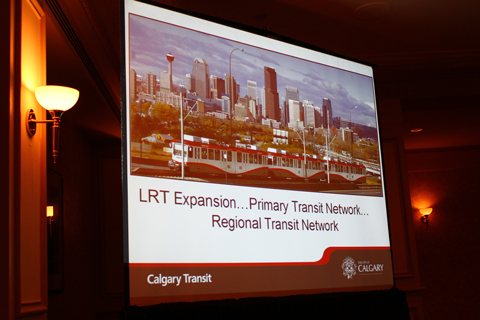
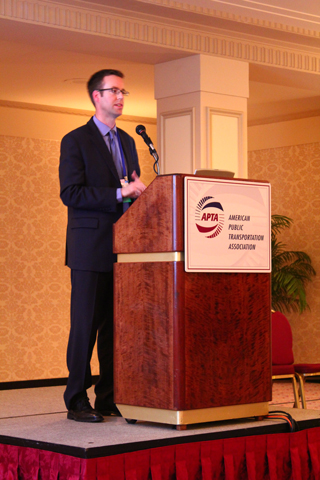
Chris Jordan, coordinator of strategic transit planning, Calgary Transit, Calgary, AB
Chris talked about how expansion of their C-Train LRT fits into Calgary’s primary term transportation network and regional transit network.
The system has seen unprecedented ridership growth: from 1997-2008, their population has jumped 30%, but ridership has gone up 50%, and the C-Train’s usage has gone up 150%. Over 45% of people use transit to get downtown now, beating out the car!
Ridership on the newest extension on the northeast line has put ridership up 7% to 26,500 daily; the impact is that bus services have shorter routes and are now 33% more frequent. Walking to stations is up too. Extension to a west line has big opportunities for transit-oriented development.
Ridership is built for the LRT system by starting with bus rapid transit (BRT) lines, which get traffic signal priority and queue jumping privileges. Eventually the bus rapid transit will convert over to rail, just like our 99 and 98 routes here in Vancouver.
The city also has plans for a connection to the airport – the only question is when, and who will participate in its construction. The connection would be a line from the airport the LRT’s 96th Avenue station: this plan dovetails with a proposal from the Province of Alberta to build high speed rail between Calgary and Edmonton, which would have a station at 96th Avenue.
Overall, LRT expansion fits into a new long-term objective for the agency, which is to make make Calgary transit the preferred mobility choice for Calgarians. In the future, they want to build a high capacity Primary Transit Network that you can live next to without needing a car (service 10 minutes or better, 15 hours a day, 7 days a week).
So for their 30 year plan, they want to increase hours of transit per capita by two percent each year. That includes increasing the bus fleet from 900 to 2200, C-Train fleet from 156 to 320 cars, and expand LRT from 44 km to 104 km. It’s a two generation plan and is intended to lead land use planning to a certain extent.
Key immediate work includes expanding capacity on the system by moving their trainsets to four cars, and improving the layout of interlining in downtown Calgary.
For more, visit the Calgary Transit website’s future projects page.
AMT’s Major Projects: Imagine, Explore And Build Tomorrow’s Transit System
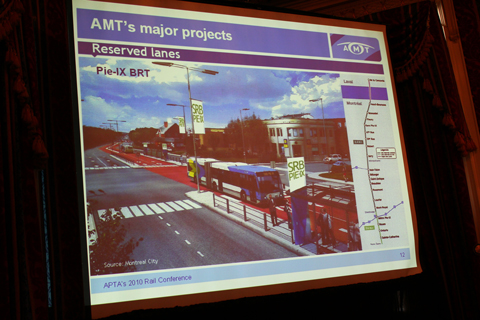
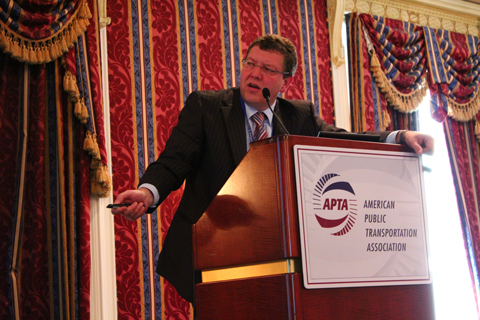
Joel Gauthier, president and chief executive officer, AMT Montreal (Agence Metropolitaine de transport), Montreal, QC
I only managed to catch the back end of this presentation, as another session ran late!
Anyway, AMT plans, integrates and coordinates public transit in the Montreal region, similar to what TransLink does here in Vancouver. There was much being said about their commuter rail system but I missed most of it!
I did catch that the federal government is also helping to build a 19 station bus rapid transit system, sort of like to our 99 service, along the Pie-IX corridor. The Quebec government, Montreal residents, and the mayor of Montreal are also quite keen on expanding the subway within the city of Montreal, and studies on those extensions will be completed three years from now.
But the last slide was great: it was about conditions for success for major projects, and how to manage the complex processes of major projects. Joel suggested the following points:
– action-oriented governance
– close collaboration among all partners
– opennness and attentiveness towards our clients and the general public (great quote that everyone laughed at: “There’s so much Monday morning quarterbacking in our industry; even my mother has opinions on the system”)
– strong political will and financing that measures up to our ambitions
– believe in your projects (“If you’re going forward with the project, you don’t have to stop the first time the media makes a story about it. You have to go in front of people complaining and explain your project. Sometimes you have to compromise, and you are going to have success.”)
For more information, here’s the AMT’s major projects page.
Transit Choreography: Making Buses And Light Rail Dance On The Portland Mall
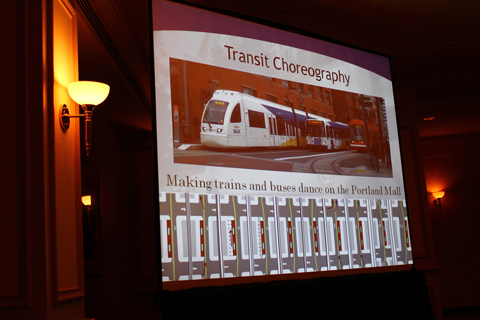
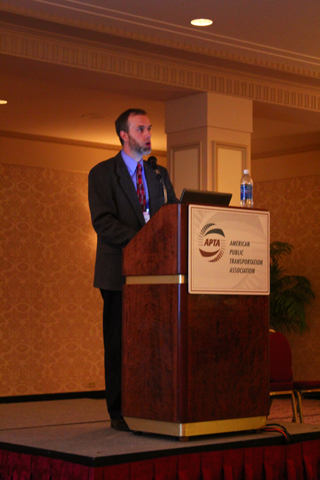
Alan T. Lehto, manager, transit corridor planning, Tri-County Metropolitan Transportation District of Oregon, Portland, OR
This wasn’t an update, but rather a really interesting explanation of how Tri-Met introduced LRT to the Portland Mall—a three-lane, one-way street in downtown Portland where the two right-hand lanes have historically been dedicated to bus traffic only.
The challenge was getting the long trains to “dance” with the two lanes of bus traffic so that service remained reliable and collisions were avoided. It’s no small challenge: lots of bus operators were so daunted that many said they would retire before the LRT moved to the Mall!
Now I don’t want to bungle the explanation, so I’d advise checking Wikipedia for an overview of the challenge, and you can watch this YouTube video to see the solution they came up with.
There were some great notes on the solutions process however. TriMet came up with 13 different options for ways to get the buses and trains integrated – and they wound up using none of those solutions, as they wanted something more simple and intuitive. They built a scale model of the Mall and they ran scale models of the buses and trains on it until they felt they had a workable solution: then they practiced in the maintenance yard using traffic cones and real buses to simulate it.
So the lesson learned was: don’t be afraid to have more options, and use your schedule to force decision making discipline early in the process, rather than forcing it by budget requirements.
Also, one awesome note: Alan mentioned that TriMet encourages its community affairs staff to go out and meet every merchant and person along their alignment. That way, everyone can know the TriMet staff well and can feel more plugged into the process: during the Portland Mall reconstruction, the only complaints from merchants were about adjacent private construction work!
Toronto’s Subway and LRT Expansion Plans
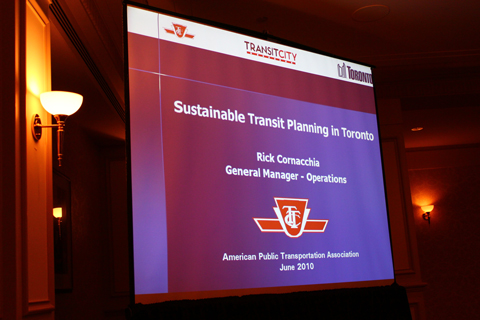
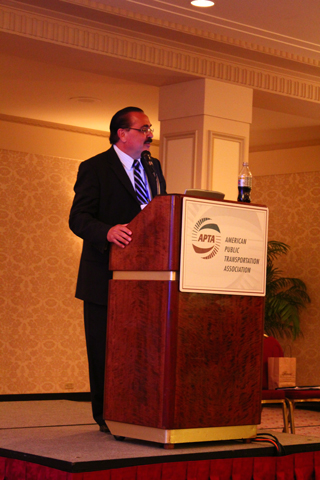
Rick Cornacchia, general manager, operations, Toronto Transit Commission (TTC), Toronto, ON
The Toronto Transit Commission (TTC) is the city-owned transit provider for the City of Toronto: it carries 470 million annually on an integrated network of buses, streetcars and trains.
Rick did a quick overview of the future projects planned for the Toronto area. The City is looking more and more to public transit solutions to help ease traffic congestion, smog, and the growing concern about climate change. The City’s official plan has a pro-transit orientation, aims for transit oriented development, and does not include construction of any new roads: it has a goal of moving people, not cars.
The major strategy is building a number of new LRT lines under the project name “Toronto Transit City Light Rail Plan” (or just Transit City for short) — it will be a new network of north-south, east-west lines connecting heavily used corridors in the city. While Toronto’s a subway town, Rick said, much more LRT can be built for the cost. Some roadspace is planned to be reallocated, with LRT running down the centre of roads to reach its destinations.
As seems the case with all transit agencies, there’s a grand plan but funding is in short supply. At a glance here’s the estimated costs of the projects:
– Finch line $1.28 billion (11 km, 20 stops, finished by fall 2014)
– Eglinton Crosstown line: $6.1 billion (10km underground, done by 2020)
– Scarborough RT upgrade: $5 billion (9.5km, 8 stations, start 2015, end 2020)
– Spadina extension: $2.6 billion (8.6 km, 6 station cut and cover, end 2015)
– Yonge line (not approved): $2.95 billion projected
There’s also other challenges: upgrading their 50 year old signal system, increasing capacity and headways, buying 70 new 6-car subway trains instead of 2-car trainsets ($925 million), streetcar fleet renewal, buying new LRT cars ($1.23 billion). 1,500 new buses have been bought in the past few years too, half of them hybrids—more bus service will be needed to match the increase in rail service, which they plan to have up 20 hours a day, 7 days a week.
For more info on these projects, check the TTC’s project website.






Sitting a few rows behind you at this presentation yesterday I have one minor correction I noticed. Edmonton said they were aiming to get all these new LRT lines done by 2016 in order to accommodate the 2017 World Fair, not the 2016.
This goes to show that Calgarians really love their public transit system. Ridership on the C-train has increased over the years, and there was demand to extend the lines purchase newer vehicles. The City of Calgary has met this demand, following it’s past success of using less expensive technology on it’s vehicles and saving operational costs by building right of way and elevated rail lines rather than digging through tunnels which increases costs.
For Edmonton, I’m quite surprised that they are switching to right of way streetcar-type technology rather than LRT. The extension from Mckernian/Belgravia to Century Park stations has attracted new riders and increased ridership since the opening. I don’t think the short distanced stations is that of a good idea, since most people in Edmonton commute from outside of downtown. Another reason is that low-floor LRT cars are more like streetcars (Remember the Olympic Line streetcar?) they are not as fast as the current fleet of LRT vehicles.
So far the only success from Toronto’s TTC is the upgrading of it’s fleet of buses and increasing service levels. Between 2007-2009 the TTC has purchased newer Next Generation Orion VII hybrids. Ridership levels have gradually increased but the problem was despite how green these buses were, they kept breaking down. So the TTC decided to go back to purchasing clean desiel buses and replace the current fleet of hybrids with lithium ion batteries instead of the lead acid ones. On the Transit City side, parts of the project are either delayed or in limbo due to cutbacks from the provincial government. The Scarborough RT for example, was supposed to upgraded this year to allow for expansion, but that was delayed until after the Pan-Am Games in 2015. And the new rocket subway trains which were supposed to be on the rails this spring were delayed until this fall also due to funding, manufacturer problems.
Matt: thanks for the catch! Fixed now.
…
I found your entry interesting do I’ve added a Trackback to it on my weblog :)…
@Jhenifer.
Not sure if this is a typing error or the presenter gave the wrong facts.
In the Edmonton presentation. It says “Some basic city facts: Metro Edmonton has a population of over 1 million, spread out over an area of 264 square miles”
That 264 square miles is only for the city proper of Edmonton and not the Metro region. The actual metro region is 3636 square miles.
To compare it to the Vancouver region. Vancouver proper is 44 sq miles and the Metro is 1,111 sq miles.
Paul C:
You’re right — either I heard wrong or it was misstated, but it will be corrected now!